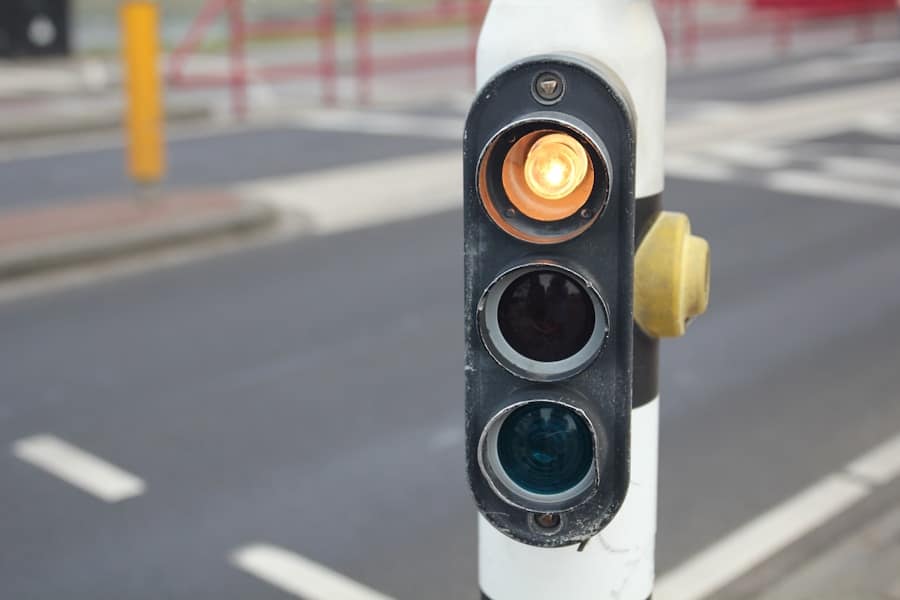Smart traffic light systems represent a significant advancement in urban traffic management, leveraging technology to enhance the efficiency and safety of roadways. These systems utilize a combination of sensors, cameras, and artificial intelligence to monitor traffic conditions in real-time, allowing for dynamic adjustments to traffic signal timings. Unlike traditional traffic lights, which operate on fixed schedules, smart traffic lights can adapt to changing traffic patterns, responding to fluctuations in vehicle volume, pedestrian activity, and even emergency vehicle movements.
This adaptability is crucial in modern cities where congestion and delays are common challenges. The integration of smart traffic light systems into urban infrastructure is not merely a technological upgrade; it signifies a paradigm shift in how cities approach traffic management. By harnessing data analytics and machine learning algorithms, these systems can predict traffic trends and optimize signal timings accordingly.
For instance, during peak hours, the system may extend green light durations for heavily trafficked routes while minimizing wait times for side streets. This level of responsiveness not only improves the flow of vehicles but also enhances the overall commuting experience for drivers and pedestrians alike.
Key Takeaways
- Smart traffic light systems use automation to improve traffic flow and reduce congestion.
- Automation in traffic management brings benefits such as improved efficiency, reduced travel time, and lower fuel consumption.
- Automation improves traffic flow by adjusting signal timings based on real-time traffic conditions and prioritizing high-traffic areas.
- Automation plays a crucial role in reducing traffic congestion by optimizing signal timings and coordinating traffic patterns.
- Automation in smart traffic light systems enhances safety by reducing the risk of accidents and improving pedestrian and cyclist flow.
The Benefits of Automation in Traffic Management
The automation of traffic management through smart systems offers numerous benefits that extend beyond mere convenience. One of the most significant advantages is the reduction in human error. Traditional traffic management often relies on manual oversight, which can lead to mistakes due to fatigue or misjudgment.
Automated systems eliminate this variable by relying on data-driven algorithms that consistently make decisions based on real-time information. This reliability is particularly important in high-stakes environments where the consequences of mismanagement can lead to accidents or severe delays. Moreover, automated traffic management systems can significantly enhance operational efficiency.
By continuously analyzing traffic data, these systems can identify patterns and trends that may not be immediately apparent to human operators. For example, if a particular intersection consistently experiences heavy congestion during specific times of the day, the system can proactively adjust signal timings to alleviate bottlenecks before they occur. This proactive approach not only improves traffic flow but also reduces the wear and tear on infrastructure, ultimately leading to lower maintenance costs over time.
How Automation Improves Traffic Flow
Automation plays a pivotal role in improving traffic flow by enabling real-time adjustments to signal timings based on current conditions. Traditional traffic lights operate on fixed cycles, which can lead to unnecessary delays during periods of low traffic or exacerbate congestion during peak hours.
This data is processed instantaneously, allowing the system to modify signal phases dynamically. For instance, if a smart traffic light detects an unusually high volume of vehicles approaching an intersection, it can extend the green light duration for that direction while shortening the red light for cross traffic. This flexibility not only minimizes wait times for drivers but also encourages smoother transitions through intersections.
Additionally, these systems can prioritize public transportation vehicles, such as buses or trams, by extending green lights as they approach, thereby promoting the use of mass transit and reducing overall vehicle numbers on the road.
The Role of Automation in Reducing Traffic Congestion
Traffic congestion is a pervasive issue in urban areas, often resulting in wasted time, increased fuel consumption, and heightened stress levels among commuters. Automation in traffic management offers a robust solution to this problem by optimizing signal timings and improving overall traffic flow. By analyzing real-time data from various sources—such as road sensors, GPS data from vehicles, and historical traffic patterns—automated systems can identify congestion hotspots and implement strategies to mitigate them.
One effective strategy employed by smart traffic light systems is adaptive signal control technology (ASCT). ASCT continuously adjusts signal timings based on current traffic conditions rather than relying on pre-set schedules. For example, if a major thoroughfare experiences an unexpected surge in traffic due to an event or accident, the system can quickly adapt by extending green lights for that route while managing side streets accordingly.
This responsiveness helps to disperse congestion more effectively than traditional methods, leading to shorter travel times and reduced frustration for drivers.
Automation and Safety in Smart Traffic Light Systems
Safety is a paramount concern in traffic management, and automation plays a crucial role in enhancing safety at intersections and along roadways. Smart traffic light systems are equipped with advanced features that contribute to safer driving conditions. For instance, many systems incorporate pedestrian detection technology that can identify when individuals are waiting to cross the street.
When pedestrians are detected, the system can automatically adjust signal timings to ensure their safe passage. Furthermore, automated systems can communicate with connected vehicles to provide real-time information about upcoming signals. This communication allows drivers to anticipate changes in signal status and adjust their speed accordingly, reducing the likelihood of sudden stops or collisions at intersections.
Additionally, smart traffic lights can be programmed to prioritize emergency vehicles by detecting their approach and altering signals to create a clear path. This capability not only expedites emergency response times but also enhances overall public safety.
The Environmental Impact of Automation in Traffic Control
The environmental implications of automated traffic management are significant and multifaceted. One of the primary benefits is the reduction of greenhouse gas emissions associated with idling vehicles. Traditional traffic signals often lead to prolonged stops at intersections, resulting in increased fuel consumption and emissions as vehicles idle while waiting for their turn to proceed.
In contrast, smart traffic light systems optimize signal timings to minimize stops and starts, thereby promoting smoother driving patterns that reduce fuel consumption. Moreover, by improving traffic flow and reducing congestion, automated systems contribute to lower overall vehicle emissions across urban areas. Studies have shown that even small improvements in traffic efficiency can lead to substantial reductions in carbon dioxide emissions over time.
Additionally, these systems can encourage the use of public transportation by prioritizing buses and trams at intersections, further decreasing the number of individual vehicles on the road and their associated environmental impact.
Challenges and Limitations of Automation in Smart Traffic Light Systems
Despite the numerous advantages of automated traffic management systems, several challenges and limitations must be addressed for widespread implementation. One significant hurdle is the high initial cost associated with installing smart traffic light infrastructure.
Many municipalities may struggle to allocate sufficient funds for such projects, particularly in areas with competing budgetary priorities. Another challenge lies in the integration of various technologies and data sources into a cohesive system. Smart traffic light systems must be able to communicate effectively with other components of urban infrastructure, such as public transportation networks and emergency services.
Ensuring compatibility among different technologies can be complex and may require extensive collaboration among various stakeholders. Additionally, concerns about data privacy and security arise as these systems collect vast amounts of information about vehicle movements and pedestrian activity.
The Future of Automation in Traffic Management
The future of automation in traffic management holds great promise as cities continue to evolve and adapt to growing populations and increasing mobility demands. As technology advances, we can expect even more sophisticated smart traffic light systems that leverage artificial intelligence and machine learning algorithms to enhance decision-making processes further. These advancements will enable cities to respond more effectively to real-time conditions while also predicting future trends based on historical data.
Moreover, the integration of autonomous vehicles into urban environments will likely reshape how smart traffic light systems operate. As self-driving cars become more prevalent, these vehicles will communicate directly with traffic management systems to optimize their routes and speeds based on current conditions. This synergy between automated vehicles and smart infrastructure could lead to unprecedented levels of efficiency and safety on roadways.
In conclusion, as urban areas continue to grapple with the challenges of congestion and safety, the role of automation in traffic management will become increasingly vital. The ongoing development of smart traffic light systems represents a significant step toward creating more efficient, safer, and environmentally friendly transportation networks that meet the needs of modern society.
In a related article discussing the benefits of automation in various industries, What is BOPIS and How Does It Work? explores the concept of Buy Online, Pick Up In Store (BOPIS) and how automation plays a crucial role in streamlining this process for retailers. Just like smart traffic light systems, the implementation of automation in BOPIS can improve efficiency, accuracy, and customer satisfaction. Both articles highlight the importance of leveraging technology to enhance operations and deliver better services to consumers.
FAQs
What is automation in smart traffic light systems?
Automation in smart traffic light systems refers to the use of technology to control and manage traffic lights without the need for human intervention. This can include the use of sensors, cameras, and algorithms to detect and respond to traffic conditions in real time.
What is the role of automation in smart traffic light systems?
The role of automation in smart traffic light systems is to improve traffic flow, reduce congestion, and enhance safety. By automating the control of traffic lights, the system can adapt to changing traffic conditions and optimize the timing of signal changes to minimize delays and improve overall traffic efficiency.
How does automation benefit smart traffic light systems?
Automation benefits smart traffic light systems by enabling them to respond dynamically to traffic patterns and adjust signal timings accordingly. This can lead to reduced travel times, lower fuel consumption, and decreased emissions. Additionally, automation can help prioritize the movement of pedestrians and cyclists, improving overall safety and accessibility.
What technologies are used for automation in smart traffic light systems?
Technologies used for automation in smart traffic light systems include traffic sensors, cameras, communication networks, and intelligent algorithms. These technologies work together to collect and analyze traffic data in real time, allowing the system to make informed decisions about signal timing and coordination.
What are the challenges of implementing automation in smart traffic light systems?
Challenges of implementing automation in smart traffic light systems include the need for reliable and accurate data collection, integration with existing infrastructure, and ensuring compatibility with different types of vehicles and road users. Additionally, privacy and security concerns related to the use of sensor and camera technologies must be addressed.



